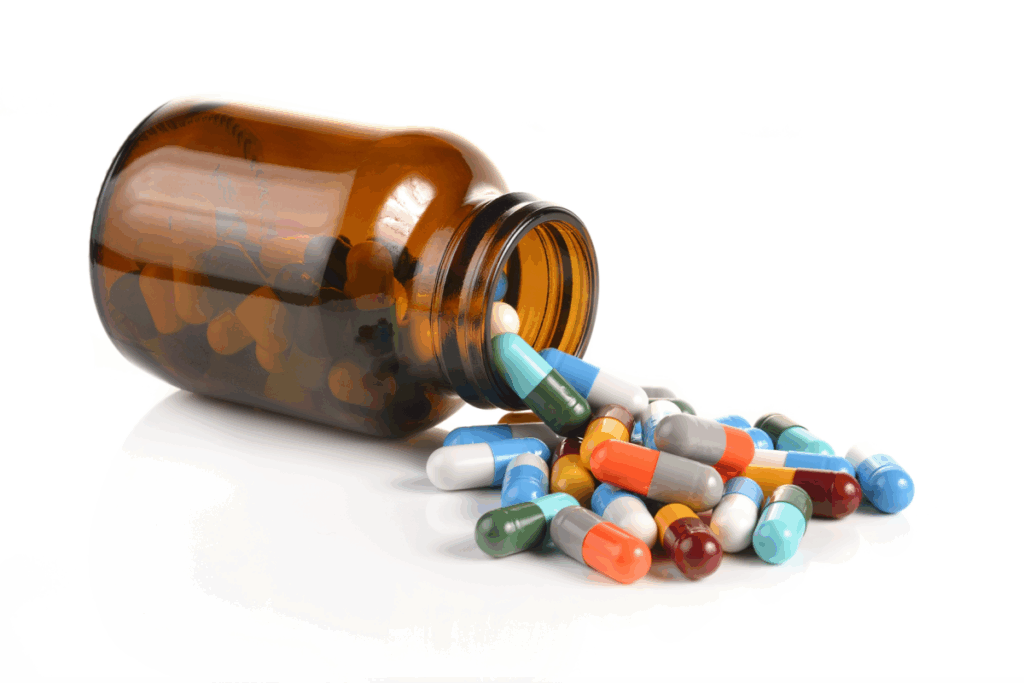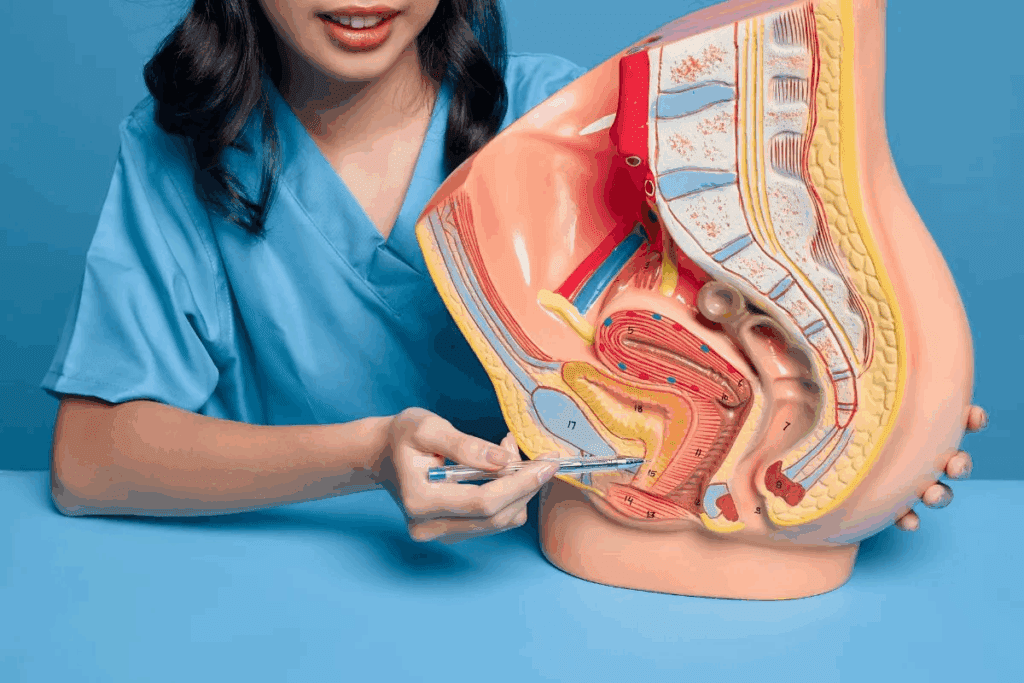Last Updated on November 25, 2025 by Ugurkan Demir

Urinary tract infections (UTIs) can really hurt, causing sudden urgency, pain, and involuntary incontinence. This can make daily life and social activities very hard. bladder control meds is a key way to manage these symptoms. Learn how to use bladder spasm medication effectively for relief from painful spasms and discomfort often associated with UTIs.
At Liv Hospital, we use Phenazopyridine to help with UTI pain, burning, and discomfort. This medicine relaxes the detrusor muscles, helping to control the bladder and ease symptoms.
It’s important to know why bladder spasms happen and how antispasmodic medication helps with UTIs. We aim to give our patients the best, evidence-based care.

It’s important to know how bladder spasms and UTIs are connected. Bladder spasms can make UTIs worse, causing more pain and slowing down recovery.
UTIs irritate the bladder lining and muscle, causing spasms. This irritation makes the detrusor muscle contract without control. It’s like a muscle cramp in the bladder.
These spasms can be very painful and make you feel like you need to urinate right away. Sometimes, they can even cause you to leak urine. Antispasmodic drugs for bladder can help by relaxing the muscle and reducing spasms.
Bladder spasms can cause a sudden, strong urge to urinate, followed by painful urination. You might also feel like you need to urinate a lot or have trouble emptying your bladder. In bad cases, you could even lose control of your bladder, leading to urinary incontinence.
It’s key to recognize these symptoms and see they’re linked to the UTI and spasms. Treating the UTI and using bladder antispasmodic drugs can help manage these symptoms. This can greatly improve your quality of life.

It’s important to understand how UTIs and bladder spasms are connected. UTIs can irritate the bladder, causing spasms. These spasms are not just uncomfortable; they can also slow down recovery.
When a UTI happens, bacteria infect the urinary tract. This causes inflammation and irritation. The body responds by contracting and relaxing the bladder muscle, leading to spasms.
Antispasmodic medications, like oxybutynin, tolterodine, and solifenacin, help manage these symptoms.
Treating bladder spasms is key to improving UTI recovery. Reducing spasms makes patients feel less discomfort and can speed up healing. Antispasmodic medications relax the bladder muscle, reducing spasms.
Some medications, like phenazopyridine, can turn urine orange-red and stain clothes.
Managing bladder spasms improves patient comfort and supports UTI treatment. Healthcare providers can offer better care by addressing both the infection and spasms.
Bladder spasm medication works by affecting the bladder’s muscles. It helps ease the pain caused by urinary tract infections (UTIs).
Medications for bladder spasms, like anticholinergics, block acetylcholine. This neurotransmitter makes the bladder muscles contract. By stopping these contractions, the medicine lessens bladder spasms.
Oxybutynin, a common anticholinergic, can cause dry mouth. To help, patients might use sugarless candy or gum.
The detrusor muscle is in the bladder wall. It’s key for bladder contractions and relaxation. Medication stops this muscle from contracting on its own, reducing spasms and UTI symptoms.
These medicines relax the bladder’s smooth muscles. This stops spasms and eases UTI discomfort. It’s important for those with frequent UTIs to improve their quality of life.
| Medication Type | Mechanism of Action | Common Side Effects |
| Anticholinergics | Blocks acetylcholine effects | Dry mouth, constipation |
| Beta-3 Adrenergic Agonists | Relaxes detrusor muscle | Headache, urinary tract infection |
Knowing how bladder spasm medication works is key to managing UTIs. These medicines target the main causes of bladder spasms. They offer a valuable treatment for those looking to ease UTI symptoms.
Bladder spasm medication is key in easing UTI discomfort. We’ll look at the different types, how they work, and their benefits.
Anticholinergic medications are a common choice. They block acetylcholine, a neurotransmitter that causes bladder muscle contractions. Oxybutynin and tolterodine are examples.
These meds help reduce bladder spasms. But, they can cause dry mouth and constipation.
Beta-3 adrenergic agonists are another option. They relax the bladder muscle, increase bladder capacity, and lessen spasms. Mirabegron is a beta-3 adrenergic agonist.
These meds have fewer side effects than anticholinergic ones, making them a good choice for some.
Combination therapies are used in some cases. They mix anticholinergic medications with beta-3 adrenergic agonists.
These combos work well for those not helped by one medication. But, they might increase side effects.
Here’s a summary of the different types of bladder spasm medications:
| Medication Type | Mechanism of Action | Examples | Common Side Effects |
| Anticholinergic | Blocks acetylcholine | Oxybutynin, Tolterodine | Dry mouth, Constipation |
| Beta-3 Adrenergic Agonist | Relaxes bladder muscle | Mirabegron | Hypertension, Headache |
| Combination Therapy | Combines mechanisms | Varies | Varies |
Talking to a healthcare provider is key to finding the right treatment for you.
Several antispasmodic medications are effective against bladder spasms from UTIs. They relax the bladder muscles, reducing spasms. We’ll look at oxybutynin, tolterodine, solifenacin, and trospium chloride.
Oxybutynin is an FDA-approved medication for detrusor overactivity. It blocks acetylcholine, a neurotransmitter that causes muscle contractions. Oxybutynin reduces bladder spasms and improves urinary continence. But, it can cause dry mouth, constipation, and anxiety or hallucinations at first.
Tolterodine treats bladder spasms. It’s selective, reducing side effects. Tolterodine manages overactive bladder symptoms like frequency and urgency. Side effects include dry mouth, headache, and stomach issues.
Solifenacin is a daily anticholinergic for overactive bladder. It blocks muscarinic receptors in the bladder. Solifenacin balances effectiveness and tolerability well. Side effects are dry mouth, constipation, and blurred vision.
Trospium chloride is a quaternary amine anticholinergic. It treats overactive bladder with minimal brain side effects. Trospium chloride reduces urinary frequency and urgency. Side effects are dry mouth, constipation, and stomach upset.
In conclusion, these medications offer benefits and have different side effects. The right choice depends on the patient’s needs and history.
Understanding the difference between prescription and over-the-counter (OTC) medications for bladder spasms is key. There are many ways to relieve bladder spasms, and the right choice depends on several factors.
For severe or ongoing bladder spasms, prescription meds are often needed. These include anticholinergics and beta-3 adrenergic agonists. For example, oxybutynin and tolterodine relax the bladder muscle and reduce spasms.
Doctors usually recommend prescription meds when symptoms are severe or affect daily life. It’s important to talk to a healthcare provider to find the best treatment.
For mild bladder spasms, OTC meds might be enough. Phenazopyridine is a common OTC drug that eases urinary tract pain and discomfort. It’s sold under different brand names and often used with antibiotics for UTI symptoms.
Phenazopyridine won’t cure infections but can ease discomfort. Always follow the dosage instructions and see a doctor if symptoms don’t improve.
Prescription and OTC meds have different strengths. Prescription meds are stronger and better for severe symptoms but might have more side effects. OTC options like Phenazopyridine work well for mild symptoms but may not be enough for severe cases.
The choice between prescription and OTC meds depends on the patient’s needs and symptom severity. Some might need a mix of both, under a doctor’s guidance, for better relief with fewer side effects.
Getting the right dose of bladder spasm medication is key to feeling better. When used correctly, these drugs can really help with UTI symptoms. This can lead to better health outcomes for patients.
Each bladder spasm medication has its own dosage rules. For example, Oxybutynin, a common drug, starts at 5 mg taken two to three times a day. The doctor might change the dose based on how well it works and how the patient feels.
It’s very important to follow the exact dosage advice from your doctor. This advice can change based on your health history and how bad your symptoms are.
When you take bladder spasm medication can affect how well it works. Some drugs work better if taken at the same time every day. This keeps the drug levels in your body steady.
For instance, Tolterodine is taken twice a day, and Solifenacin once a day. Taking your medication at the same time each day helps it work better.
How long you need to take bladder spasm medication depends on why you’re taking it and how you respond. Treatment usually goes on until your symptoms get better or go away.
In some cases, you might need to keep taking the medication for a longer time. This could be to stop symptoms from coming back or to manage ongoing conditions.
Some medications can be taken with or without food. For example, Oxybutynin can be taken either way. But, taking it with food might help avoid stomach upset.
It’s very important to follow what your doctor or the medication’s instructions say about food. This can help you get the most out of your treatment.
| Medication | Standard Dose | Frequency | Food Intake |
| Oxybutynin | 5 mg | 2-3 times daily | With or without food |
| Tolterodine | 2 mg | Twice daily | With or without food |
| Solifenacin | 5 mg or 10 mg | Once daily | With or without food |
By knowing and following the right dosage and administration guidelines, patients can get the most benefits from their medication. This can also help reduce side effects.
Knowing when to start treatment for UTIs is key. Starting bladder spasm medication early can help a lot. It can make symptoms better and improve how you feel.
Starting bladder spasm medication early has many benefits. It can lessen pain and the need to urinate often. This makes life better for the patient.
It also helps with antibiotic treatment, which is main for UTIs. By easing symptoms, patients are more likely to take their antibiotics. This makes treating the infection more effective.
It’s important to use bladder spasm medication with antibiotics. Starting antibiotics quickly is key to fight the infection.
For example, Phenazopyridine can help with pain and urgency. But, stop it if symptoms don’t get better after two days. Or if you have fever, chills, or back pain, as these could mean a serious infection.
| Medication | Purpose | Timing Considerations |
| Phenazopyridine | Relieves UTI symptoms | Stop if symptoms persist after 2 days or if fever, chills, or back pain occur |
| Antibiotics | Treats underlying UTI infection | Start as soon as possible |
| Bladder Spasm Medication | Manages bladder spasms | Can be started alongside antibiotics |
Keeping an eye on how symptoms change is important. Patients should tell their doctor about any changes or worries.
By watching symptoms, doctors can see if treatment is working. This helps make sure patients get the best care for their UTI.
Knowing about the side effects of bladder spasm medication is important. These drugs help with UTI symptoms but can cause side effects in some. It’s vital to manage these side effects well.
Side effects of bladder spasm medications vary by drug. For example, oxybutynin can cause dry mouth and drowsiness. These effects are usually mild and may lessen over time.
Other drugs like tolterodine and solifenacin can lead to constipation and blurred vision. It’s important to talk to your doctor about any side effects. They might need to adjust your treatment.
Some medications can cause serious side effects, though rare. Phenazopyridine, for instance, can lead to angioedema, a severe allergic reaction. This can cause swelling and needs immediate medical care.
Be aware of serious side effects and seek help if you notice them. Regular check-ups with your doctor can catch issues early.
To avoid unwanted effects, follow your medication’s dosage and instructions. Taking it with food can help with stomach issues. Drinking plenty of water and eating well can also help.
Tell your doctor about all medications you’re taking. This can prevent drug interactions that worsen side effects. Working with your healthcare team can help find the best treatment with fewer side effects.
Medications for bladder spasms can be helpful, but knowing how they interact with other drugs is key. It’s important to look at a patient’s overall health and what medications they’re taking.
Some drugs shouldn’t be taken with bladder spasm meds because they can cause bad reactions. For example, Oxybutynin, a common drug, can mix badly with other sedatives.
It’s best to stay away from alcohol when taking these meds. It can make you feel drowsy and dizzy. Caffeine might help some but can also make you need to pee more often.
Conditions like glaucoma, gastrointestinal obstruction, or urinary retention can make these meds riskier. People with these issues need close watch and might need their doses changed.
Knowing about these safety tips and drug interactions helps doctors give better care for bladder spasms. This way, treatment is both effective and safe.
When treating UTIs with bladder spasm medication, we must think about different patient groups. Age, pregnancy, and health conditions can affect how well these medicines work and how safe they are.
Elderly patients need special care with bladder spasm medication. Oxybutynin, a common choice, can cause more side effects in older adults, like dry mouth and confusion. We should carefully consider the benefits and risks and look for safer options.
A study showed that older patients are more likely to experience side effects from oxybutynin. So, it’s important to watch them closely and adjust their treatment as needed.
Pregnant and nursing women also need careful consideration. Some bladder spasm medications are safe, but others are not. For example, tolterodine is a Category C drug, meaning it may harm the fetus but there’s no human data.
Nursing mothers should talk to their healthcare providers about the safety of these medications. We want to find a balance between treating UTIs and keeping the baby safe.
Patients with other health issues, like liver or kidney disease, need careful management. For example, phenazopyridine should be used with caution in patients with liver disease because it can harm the liver. Also, medications like trospium chloride may need to be adjusted for those with kidney problems.
| Comorbidity | Medication Consideration | Action Required |
| Liver Disease | Phenazopyridine | Use with caution, monitor liver function |
| Renal Impairment | Trospium Chloride | Adjust dose according to renal function |
Children with UTIs need special attention with bladder spasm medication. The safety and effectiveness of these medicines in kids may be different from adults. Not all medications are approved for children.
We should carefully decide if bladder spasm medication is needed for kids. If so, we should choose medicines approved for kids and follow the recommended doses.
Bladder spasm medications are key in managing UTI symptoms. They help ease the pain and discomfort of urinary tract infections. We’ve looked at how UTIs and bladder spasms are linked, the types of meds available, and how they work.
Phenazopyridine is a medication that helps with UTI pain and discomfort. Knowing about different bladder spasm meds helps people choose the right treatment for them.
Managing UTI symptoms well needs a full approach. This includes using bladder spasm meds, antibiotics, and making lifestyle changes. These steps can greatly help in feeling better and improving life quality.
In short, bladder spasm medication is essential for UTI relief. It offers many benefits and treatment options. We suggest talking to a healthcare professional to find the best treatment plan for UTI symptoms. They can help decide if bladder spasm medication is right for you.
Bladder spasm medication helps with symptoms of bladder spasms, often seen in UTIs. It relaxes the bladder muscles. This reduces how often and how bad the spasms are.
Anticholinergic medications block acetylcholine, a neurotransmitter that causes bladder muscle contractions. This helps relax the bladder and lessen spasms.
Side effects can include dry mouth, constipation, blurred vision, and dizziness. The specific side effects depend on the medication type.
Yes, you can take bladder spasm medication with other UTI treatments. But, always talk to a healthcare provider first to ensure it’s safe and effective.
Some OTC meds may help with mild bladder discomfort. But, for severe spasms, prescription meds are usually needed. OTC options might not work as well.
How long it takes for the medication to work varies. Some people feel relief in a few hours. Others might need a few days to see improvement.
Yes, but the dosage and medication type must be carefully chosen by a healthcare provider. The safety and effectiveness in kids can vary.
Elderly patients might need adjusted dosages or closer monitoring. This is because they might be more sensitive to side effects or have interactions with other meds. Always consult a healthcare provider.
It’s best to avoid or limit alcohol and caffeine while taking the medication. These substances can interact with the medication or worsen side effects.
If you have severe side effects like allergic reactions, breathing trouble, or chest pain, get medical help right away. For milder side effects, talk to your healthcare provider for advice.
Track your symptoms to see if the medication is working. Look for fewer or less severe spasms. Regular check-ups with your healthcare provider can also help.
Using bladder spasm medication long-term should be discussed with a healthcare provider. It might be needed for some, but it’s important to monitor for side effects.
National Center for Biotechnology Information. (2025). How to Use Bladder Spasm Medication for UTI. Retrieved from https://www.ncbi.nlm.nih.gov/books/NBK459272/>
Subscribe to our e-newsletter to stay informed about the latest innovations in the world of health and exclusive offers!